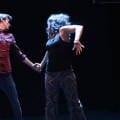As a company, it is important that we play to our strengths in order to create the strongest piece of theatre that we possibly can, two aspects that seemed to be coherent throughout the performers were movement and music. Some of our performers are dance trained and others strong at singing and playing instruments. Therefore we thought it necessary to utilise these talents in order to form a piece of theatre that achieved what we set out to do.
Physical movement – falling
As the basis of our piece revolves around bringing photos to life, we have been focusing on movement and the body and how we can use them to physicalise aspects of photos. Our director’s aim was to get us to view photos in alternate ways, one such photograph being the falling image from 9/11. When we initially saw the image we just took it as two people trying to escape the horror of the 9/11 attacks. However, upon looking at the image in detail we were challenged to ask the questions, What were they thinking? What was the relationship between the two people? What could have been their last words?
Our choreographer, Tom, created a sequence of simple repetitive, yet amazingly effective movements, influenced by the falling picture (below). Through the repetition of such simple movement, our expression and emotion will hopefully be the focus of the audience’s attention and they will understand the emotion that we saw in the photo. Within the sequence Morgan and I were given a duet in which we were representing the image. Throughout it there were numerous moments in which we reached out, grasping each other aiming to depict the passion and desperation that we think the people would have been experiencing at the moment the picture was taken.
However, one challenge we faced was making the choreographed movement appear spontaneous, natural and emotive. As Alfreds explains, ‘actors, by playing a continuous, seamless flow of actions, should consequently experience a seamless flow of feelings that shift and adapt to the ever-changing circumstance in which they’re evoked.’ (2007, 92). Therefore, in order for the piece to work, the movement must not look rehearsed otherwise it will lose the passion behind it. Consequently, we found that we needed to react rather than ‘act’ to the movement truthfully in order to evoke the emotion that Tom wanted.
Works Cited
Alfreds, M. (2007) Different Every Night: Freeing the Actor. London: Nick Hern Books Limited.
The Death Posture (2013) [Photograph] At: http://timeconsumerrr.tumblr.com/ [Accessed 6 March 2015].


